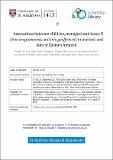Interactions between children, teenagers and botos (Inia araguaiaensis and Inia geoffrensis) in markets and fairs of Eastern Amazon
Abstract
In this study we present the first record of interactions (ludic behavior, swimming and induced feeding) involving river dolphins known as botos (Inia sp.) and children/adolescents (from eight to 17 years old) at markets and fairs at the river front of two localities of Pará State, Brazil. We registered the reports of the participants using semi-structured interviews while they were working at the markets or when they were in the water to interact with river dolphins. We registered dolphins and human behavior using the ad libitum method. Most of the children interacting with botos were boys - we observed only two girls swimming with the dolphins. All the fish species offered to river dolphins are commercial. Tourists were often involved in interactions in the Santarém region, but not as frequently in the city of Mocajuba. Nevertheless, in both places human populations were aware of the interactions of children/adolescents with botos. The interviewees did not show fear of botos, as is common in other localities of Pará State. Although some of them attributed mystical powers to those animals. The children demonstrated to know about river dolphins behavior and morphology, as well as the occurrence of other species of aquatic mammals in the surrounding areas. Despite the diversity of aquatic mammals in those areas, we noticed that the knowledge of children regarded mainly botos and tucuxis (another river dolphin species), probably because these are the most conspicuous aquatic mammal species in the region. Furthermore, according to the reports of the interviewees these interactions between dolphins and humans have been going on for a long time in both areas, more than 30 years. The presence of newborn calves along our field observations indicate that this behavior may be passed down through generations of botos. In short, our results expand the knowledge regarding interactions between humans and Inia sp. in the Amazon. Moreover, it is essential to intensify the systematic research effort in order to evaluate effects of direct interaction activities on river dolphins and humans alike. In addition, educational measures in Eastern Amazon may promote realistic and efficient plans for the conservation of this species.
Citation
Figueiredo Rodrigues , A L , Melo-Santos , G , Ramos-Santos , I , Andrade , A M , Arcoverde , D L , Sena , L & da Silva , M L 2019 , ' Interactions between children, teenagers and botos ( Inia araguaiaensis and Inia geoffrensis ) in markets and fairs of Eastern Amazon ' , Ocean and Coastal Management , vol. 172 , pp. 137-145 . https://doi.org/10.1016/j.ocecoaman.2019.02.005
Publication
Ocean and Coastal Management
Status
Peer reviewed
ISSN
0964-5691Type
Journal article
Description
The first author was granted by a scholarship of the Conselho Nacional de Desenvolvimento Científico e Tecnológico (CNPq). The second author and the fifth authors were granted scholarships from Coordenação de Aperfeicoamento de Pessoal de Nível Superior (CAPES, Brazil).Collections
Items in the St Andrews Research Repository are protected by copyright, with all rights reserved, unless otherwise indicated.

